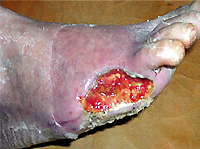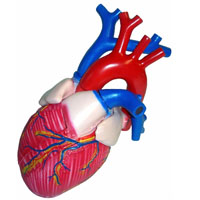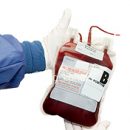A trophic ulcer is an ulcer resulting from a tissue nutrition. Most often they develop in varicose disease, but this is not the only reason for the occurrence. Read more about the types of trophic ulcers and their manifestations in the article.
Content
Trophic ulcers are a defect of the body tissues (skin or mucosa). Under the trophic ulcer, they understand the open wound on the leg or foot, which does not heal more than 6 weeks. Multicken healing is the most characteristic feature of trophic ulcers. They are extremely long not heal and prone to progression. Another feature of this disease is a high tendency to constant relapses and exacerbations. An equally characteristic feature of trophic ulcers - they are very difficult and reluctant to treat. If a trophic ulcer cure, but not to treat the main disease that caused the formation of ulcers, then it will definitely appear again.
Development of trophic ulcers and its symptoms
 Trophic ulcers develop as a consequence of many diseases, mainly varicose veins and chronic venous insufficiency. But, regardless of the cause, the mechanism for the development of trophic ulcers, as a rule, one is a violation of blood and lymph movement, as well as damage to large nerves, spinal cords, various skin injuries, soft tissues or some diseases (such as Siringomyeli). Also, many skin diseases are also known, which, with long flow, lead to the appearance of trophic ulcers on the legs.
Trophic ulcers develop as a consequence of many diseases, mainly varicose veins and chronic venous insufficiency. But, regardless of the cause, the mechanism for the development of trophic ulcers, as a rule, one is a violation of blood and lymph movement, as well as damage to large nerves, spinal cords, various skin injuries, soft tissues or some diseases (such as Siringomyeli). Also, many skin diseases are also known, which, with long flow, lead to the appearance of trophic ulcers on the legs.
Favorite place of trophic ulcers - lower third of the leg. Ulcers can be solitary and multiple. Usually ulcer has a rounded, oval or incorrect shape, sizes are the most different, sometimes it covers the nickname. The edges of the trophic ulcers edema and dense. The skin around acquires a brown or blue painting and also becomes dense. Bottom of ulcers, as a rule, flat, shallow, release of transparent or muddy-white liquid.
In addition to the defect itself, patients usually complain about the swelling of the lower extremities, constant pain, increasing after exercise and long walking.
Varieties of trophic ulcers and their current
Venous trophic ulcers
Appear during running vendor diseases. The trophic ulcer most often leads the launched varicose disease and inflammation of deep veins. Ulcers can sometimes close without the help of a surgeon, but then arise again.
Arterial trophic ulcers
Arterial trophic ulcers arise in violation of blood flow by arteries. They often occur with diabetes and atherosclerosis. Such ulcers are often located in the footsteps and fingers, they can hurt much, and may be painless, for example, with diabetes.
Ulcers in neurological diseases
Such ulcers are also most often located on the legs, but are found throughout the body. Ulcers in neurological diseases, the injuries of the dorsal and brain are most severely treated. Successful treatment leads to the closure of trophic ulcers.
Prevention of the development of trophic ulcers
Prevention of trophic ulcers - this is an early diagnosis and treatment of diseases that can cause their development, primarily atherosclerosis, diabetes, varicose sickness and thrombophlebitis. If the disease is already there, then you need to take the legs from injuries, wearing special shoes and an elastic bandage.









